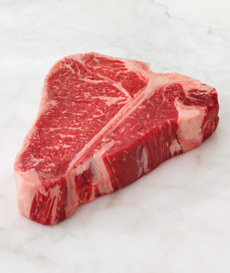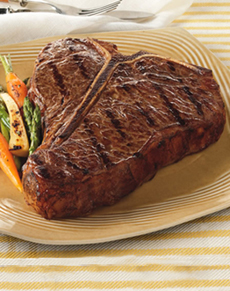TIP OF THE DAY: How To Grill The Perfect Steak
 Ready for the grill: a beautiful porterhouse steak from AllenBros.com. |
Chef Jan Birnbaum of EPIC Roasthouse in San Francisco enjoys a good steak on the grill. In fact, he designs his cookout menus so that he can cook everything outside!
Here are Chef Jan’s tips for grilling the perfect steak. 1. Don’t cook cold meat. Always allow meats to rest at room temperature for up to two hours, depending on the size of the meat. Meat directly out of a refrigerator is typically about 38°F. For best results, let it warm up a bit and put meat on the grill when it reaches an internal temperature of 50°-55°F degrees. Tempered meat produces a more desirable even-cooked color and texture, whether your goal is rare or medium. |
|
|
2. Sear first; then cook low, slow, and even. It’s best to start a steak over higher heat: The surface caramelizes and provides a better mouth feel and visual appearance, as well as a more assertive flavor. Then lower the heat so it will penetrate deeper, thus improving the chew and creating a more lush texture. Consider removing the meat from the heat altogether midway in cooking, and then return the it to the high direct heat to complete the cooking. 3. Always rest the meat after grilling, before cutting and serving. The hot juices need to settle back into the flesh. Slice into hot meat and they’ll dribble out. Food continues to cook after it has been removed from heat. Once the meat is off the heat it may continue to rise in temperature another 10%. This process is known as endothermic energy. |
||
|
4. Cook chewier cuts at higher temperatures.
From the most tender (filet mignon) to the most chewy cut (sirloin, for example), the tenderness and depth of flavor tend to be inverse to the texture of the meat. This is a function of how the animal used the particular muscle. Muscles that get more exercise produce meat that is less tender but with more depth of flavor. Cook these meats at hotter temperatures; rest them for less time and slice them thin. Muscles that are load bearing are more tender but less flavorful. 5. Live fire is best. The smokey nuances of live fire are delicious on meat. The combination of wood flame and a coal bed enhances the complexity of the eating experience. Building the fire is key to achieve this effect. Chef Jan likes a combination of walnut, oak and a bit of mesquite charcoal. |
 The porterhouse grilled to perfection. Photo courtesy AllenBros.com. |
|
|
Chef Jan prefers a professional meat fork instead of tongs; it offers more control. This fork, from Taylor, has a built-in digital thermometer. Use the tip of the fork and pierce the meat as little as possible (the juices will run out of pierced meat). Fish spatulas are good for small delicate items like fish and vegetables. The bigger, heavier jobs are best for a steel hamburger spatula. Don’t freestyle it; learn the skills. |
||


